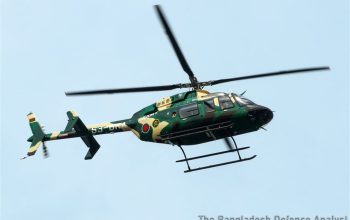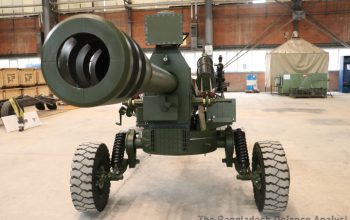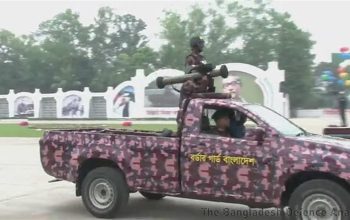The Irkut Corporation of Russia is set to deliver the next set of Yak-130 advanced jet trainers to the Bangladesh Air Force following supply of 16 aircraft in 2015-16.
In 2014 the Bangladesh Air Force had ordered 16 Yak-130’s bought using a defence hardware loan from Russia under the G2G protocol. The first batch of 6 aircraft were delivered on 20 September 2015, then second batch on 29 December 2015 followed by another 5 aircraft in the first quarter of 2016.
The Bangladesh Air Force had the option to extend the purchase to another squadron of Yak-130 aircraft under the same price. It exercised the option to purchase 10 more aircraft under the option to equip the existing Yak-130 advance jet training squadron.
Deliveries are to commence from the end of 2020. In this regard the Chief of Air Staff Air Chief Marshal Mashiuzzaman Serniabat already visited Irkut Corporation facilities in Russia and held talks with several key Russian defence industry officials from Irkut and Rosoboronexport in August 2019.
About the Yak-130
Yak-130 is an advanced pilot training aircraft, able to replicate characteristics of Russian 4th and 5th generation fighters. This is possible through the use of open architecture digital avionics compliant with a 1553 Databus, a full digital glass cockpit, four-channel digital Fly-By-Wire System (FBWS) and Instructor controlled and variable FBWS handling characteristics and embedded simulation. The type also has a Head-up display (HUD) and a Helmet-Mounted-Sighting-System (HMSS), with a double GPS/GLONASS receiver updating an Inertial Reference System (IRS) for highly accurate navigation and precision targeting. The developer estimates that the plane can cover up to 80% of the entire pilot flight training program.
In addition to its training role, the aircraft is capable of fulfilling Light Attack and Reconnaissance duties. It can carry a combat load of 3,000 kilograms, consisting of various guided and un-guided weapons, auxiliary fuel tanks and electronic pods. According to its chief designer Konstantin Popovich, during a testing phase that ended in December 2009, the plane was tested with “all airborne weapons with a weight of up to 500 kg that are in service in the Russian Air Force”. Yak-130 has nine hard points: two wingtip, six under-wing and one under-fuselage.
The aircraft’s twin engines are mounted under extended wing roots, which reach as far forward as the windscreen. Two Ivchenko Progress AI-222-25 Full Authority Digital Engine Control (FADEC) produce a combined total of 49 kilonewtons (11,000 pound-force) of thrust. An upgraded, “-28” engine is also on offer, increasing the thrust to 53 kN (12,000 lbf). At a normal Take-Off Weight of 7,250 kg (15,980 lb), a Thrust-to-Weight ratio of 0.70 is achieved with the “-25”, or 0.77 with the “-28” engines. This compares with 0.65 for the BAE Systems Hawk 128 and 0.49 for the Aero Vodochody L-159B.
Maximum internal fuel capacity is 1,700 kg (3,700 lb). With two external combat fuel tanks the figure increases to 2,600 kg (5,700 lb). Maximum true airspeed is Mach 0.93 (572 knots), service ceiling is 12,500 metres (41,000 feet) and load factors are from −3 to +9 g. Typical Take-Off speed and distance in a “clean” configuration are 209 km/h (113 kn) and 550 m (1,800 ft), whilst landing figures are 191 km/h (103 kn) and 750 m (2,460 ft), respectively. Cross wind limit is 56 km/h (30 kn).
The Yakovlev Yak-130 is equipped with the FBWS controlled engine intake blanking doors, in order to prevent the aircraft’s engines from sustaining Foreign object damage when operating from unpaved runways and grass strips.
The large canopies are sideways hinged.
Combat training suite on the Yak-130 includes simulated and real firing systems with air-to-air and air-to-surface missiles, bomb dropping, gun firing and on-board self-protection systems.
Yak-130 in operation
Yak-130 prototype completed its maiden flight, registered as RA-43130, on 25 April 1996 at Zhukovsky airfield.
On 30 April 2004, the first pre-series Yak-130, assembled at the Sokol plant in Nizhny Novgorod, performed its maiden flight. The plane was put on display for the first time at the Paris Air Show in June 2005. It was followed by three more pre-series aircraft.
In December 2009, the aircraft completed state trials and was accepted for service in the Russian Air Force.
In service with the Bangladesh Air Force since December 2015, the Yak-130 was used in an intensive manner. On 11 July 2017 a Bangladesh Air Force Yakovlev Yak-130 ‘Mitten’ training aircraft crashed at Lohagara in Bangladesh’s southeastern Chittagong District. Two pilots were unharmed.
On 27 December 2017 two Bangladesh Air Force Yakovlev Yak-130 aircraft crashed at Maheshkhali Island in Cox’s Bazar due to a mid-air collision. The official report states that the accident happened during the breaking of formation at a training exercise. All four pilots of two aircraft were rescued alive.
The crashes were a result of problems on the Yak-130’s FBW. The second crash was attributed to human error however the pilots claimed to the Defseca Team they would not see each other’s aircraft on their avionics during the night flight suggesting some problems with the jet trainer’s avionics.
The future
Each Yak-130 was purchased for $35 million, which included training and munitions. Spares were purchased separately from Russia later on.
It was widely believed the Bangladesh Air Force would purchase Su-30 heavy multi-role combat aircraft as a natural progression however no orders have been confirmed till date. The Su-30 would have been used in the maritime strike role. A dozen aircraft would be stationed at Chittagong’s Zahrul Haque airbase in this regard.
Neighbouring Myanmar currently operates 12 Yak-130 advance jet trainers. It also ordered 6 Su-30SM heavy multi-role combat aircraft. The order is likely to be increased in future to at least 12 units. By 2021 the Bangladesh Air Force hopes to become an effective fighting force with inclusion of more combat aircraft.




